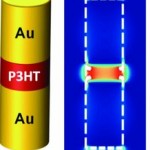Home > Press > Gold Nanoantennas boost the Emission Rate of Conjugated Polymers
 |
Abstract:
Resonant plasmonic nanoantennas have been used to control the emission of light to various degrees, as the large local density of optical states in the near-field of the nanoantenna influences the emission properties. Theoretical studies have proposed to incorporate a semiconductor material into a metal nanoantenna, in analogy to the feed element in radio frequency antennas, in order to modify the semiconductor optical properties. Until now, however, the realization of such an integrated metal-semiconductor nanoantenna remained challenging.
Gold Nanoantennas boost the Emission Rate of Conjugated Polymers
Germany | Posted on June 8th, 2012D. O'Carroll (Rutgers University) and co-workers have developed a novel fabrication process for metal-polymer-metal split-dipole nanoantenna heterostructures by sequential electrodeposition and thermal evaporation. The resonant scattering response of such antennas can be tuned to the polymer emission band by controlling the nanoantenna length. Using this approach, the radiative emission rate of poly(3-hexylthiophene) was enhanced by a factor of up to 29, in experiment, and 550 for the ideal case. Especially organic conjugated polymers such as polythiophenes, which exhibit high carrier mobilities but possess relatively poor luminescence properties, would benefit from incorporation into such plasmonic nanoantennas. This work demonstrates clearly that integrated metal-polymer-metal nanoantennas could enable a new generation of high-performance conjugated polymer optoelectronic devices.
####
For more information, please click here
Copyright © Wiley-VCH Materials Science Journals
If you have a comment, please Contact us.Issuers of news releases, not 7th Wave, Inc. or Nanotechnology Now, are solely responsible for the accuracy of the content.
| Related Links |
![]() Link to the original paper on Wiley Online Library:
Link to the original paper on Wiley Online Library:
| Related News Press |
News and information
![]() Researchers develop molecular qubits that communicate at telecom frequencies October 3rd, 2025
Researchers develop molecular qubits that communicate at telecom frequencies October 3rd, 2025
![]() Next-generation quantum communication October 3rd, 2025
Next-generation quantum communication October 3rd, 2025
![]() "Nanoreactor" cage uses visible light for catalytic and ultra-selective cross-cycloadditions October 3rd, 2025
"Nanoreactor" cage uses visible light for catalytic and ultra-selective cross-cycloadditions October 3rd, 2025
Chip Technology
![]() Lab to industry: InSe wafer-scale breakthrough for future electronics August 8th, 2025
Lab to industry: InSe wafer-scale breakthrough for future electronics August 8th, 2025
![]() A 1960s idea inspires NBI researchers to study hitherto inaccessible quantum states June 6th, 2025
A 1960s idea inspires NBI researchers to study hitherto inaccessible quantum states June 6th, 2025
![]() Programmable electron-induced color router array May 14th, 2025
Programmable electron-induced color router array May 14th, 2025
Discoveries
![]() Researchers develop molecular qubits that communicate at telecom frequencies October 3rd, 2025
Researchers develop molecular qubits that communicate at telecom frequencies October 3rd, 2025
![]() Next-generation quantum communication October 3rd, 2025
Next-generation quantum communication October 3rd, 2025
![]() "Nanoreactor" cage uses visible light for catalytic and ultra-selective cross-cycloadditions October 3rd, 2025
"Nanoreactor" cage uses visible light for catalytic and ultra-selective cross-cycloadditions October 3rd, 2025
Announcements
![]() Rice membrane extracts lithium from brines with greater speed, less waste October 3rd, 2025
Rice membrane extracts lithium from brines with greater speed, less waste October 3rd, 2025
![]() Researchers develop molecular qubits that communicate at telecom frequencies October 3rd, 2025
Researchers develop molecular qubits that communicate at telecom frequencies October 3rd, 2025
![]() Next-generation quantum communication October 3rd, 2025
Next-generation quantum communication October 3rd, 2025
![]() "Nanoreactor" cage uses visible light for catalytic and ultra-selective cross-cycloadditions October 3rd, 2025
"Nanoreactor" cage uses visible light for catalytic and ultra-selective cross-cycloadditions October 3rd, 2025
|
|
||
|
|
||
| The latest news from around the world, FREE | ||
|
|
||
|
|
||
| Premium Products | ||
|
|
||
|
Only the news you want to read!
Learn More |
||
|
|
||
|
Full-service, expert consulting
Learn More |
||
|
|
||








